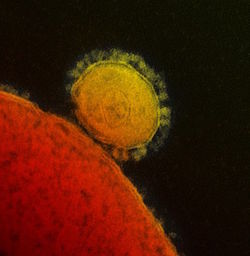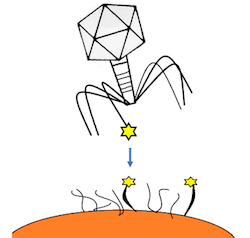Are viruses alive?
Submitted by
MelanieGrade level
9Answered by
Abigail Howell, Undergraduate, Biomedical Sciences

Scientists are not sure whether viruses are living or non-living. In general, scientists use a list of criteria to determine if something is alive. Let’s look at some traits of living things and see if viruses also have those traits.
Living things have cells. Viruses do not have cells. They have a protein coat that protects their genetic material (either DNA or RNA). But they do not have a cell membrane or other organelles (for example, ribosomes or mitochondria) that cells have.
Living things reproduce. In general, cells reproduce by making a copy of their DNA. Unlike cells, viruses do not have the tools to make a copy of their DNA. But they have found other ways to make new viruses. This is done by inserting virus genetic material into a host cell. This causes the cell to make a copy of the virus DNA, making more viruses.
Many scientists argue that even though viruses can use other cells to reproduce itself, viruses are still not considered alive under this category. This is because viruses do not have the tools to replicate their genetic material themselves.
More recently, scientists have discovered a new type of virus, called a mimivirus. These viruses do contain the tools for making a copy of its DNA. This suggests that certain types of viruses may actually be living.

Living things use energy. Outside of a host cell, viruses do not use any energy. They only become active when they come into contact with a host cell. Once activated, they use the host cell’s energy and tools to make more viruses.
Because they do not use their own energy, some scientists do not consider them alive. This is a bit of an odd distinction though, because some bacteria rely on energy from their host, and yet they are considered alive. These types of bacteria are called obligate intracellular parasites.
Living things respond to their environment. Whether or not viruses really respond to the environment is a subject of debate. They interact with the cells they infect, but most of this is simply based on virus anatomy. For example, they bind to receptors on cells, inject their genetic material into the cell, and can evolve over time (within an organism).
Living cells and organisms also usually have these interactions. Cells bind to other cells, organisms pass genetic material, and they evolve over time, but these actions are much more active in most organisms. In viruses, none of these are active processes, they simply occur based on the virus's chemical make-up and the environment in which it ends up.
What's the final answer?
When scientists apply this list of criteria to determine if a virus is alive, the answer remains unclear. Because of this, the debate of whether viruses are living or non-living continues. As the understanding of viruses continues to develop, scientists may eventually reach a final decision on this question.
If viruses are not alive how can we destroy them?
No matter what side of the debate you might be on, we know that viruses can be deactivated. Once they are inactive, they cannot infect a host cell.
There are two types of viruses, those with a lipid, or fatty outer shell and those that have a protein coating called a capsid. For the viruses that have a lipid shell you can use common soap to basically tear apart the outer coating and deactivate the virus. The remaining parts can then be washed down the sink and are harmless. The great thing about this is it only takes about 20 seconds of thorough hand washing with soap and water to do this. The virus that causes COVID-19 has a lipid shell so it can be deactivated using soap.
Viruses with protein coatings like the rhinoviruses and adenoviruses that cause the common cold are not deactivated by soap, but are still dislodged from our skin and surfaces so that they can be washed down the sink. This is also why washing your hands with soap and water is better than using a hand sanitizer. Hand sanitizers do not have the same effect of removing the viruses from our skin so they can be washed down the sink.
While we know many of you came to this page to find out whether viruses are alive or not, we've also been receiving many follow-up questions about the Coronavirus. Here are some resources we think may be helpful:
Coronavirus resources
1. Educational video by Kurzgesagt - In a Nutshell: The Coronavirus explained & what you should do
2. One of the most up-to-date Coronavirus case maps showing the numbers of confirmed cases across the globe (and split into counties within the US), from the University of Virginia.
3. For how to respond and how to act, visit the WHO's Coronavirus advice to the public.
4. For the most up-to-date testing and case numbers, visit the COVID Tracking Project.
A COVID-19 Pandemic Simulation
See how important masks and distancing are in slowing the spread in some areas. We also know how important vaccines are starting to be in helping to keep people safe from the virus. But it's hard to see how much each of those precautions matters in the bigger picture. Now, you can play out as many simulations as you want to learn how population size, masking, distancing, and vaccinating can help slow the spread of COVID-19 with COVID SIM.
Ebola Virus image by NIAID
Bibliographic details:
- Article: Are viruses alive?
- Author(s): Abigail Howell
- Publisher: Arizona State University School of Life Sciences Ask A Biologist
- Site name: ASU - Ask A Biologist
- Date published:
- Date accessed:
- Link: https://askabiologist.asu.edu/questions/are-viruses-alive
APA Style
Abigail Howell. (). Are viruses alive?. ASU - Ask A Biologist. Retrieved from https://askabiologist.asu.edu/questions/are-viruses-alive
Chicago Manual of Style
Abigail Howell. "Are viruses alive?". ASU - Ask A Biologist. . https://askabiologist.asu.edu/questions/are-viruses-alive
Abigail Howell. "Are viruses alive?". ASU - Ask A Biologist. . ASU - Ask A Biologist, Web. https://askabiologist.asu.edu/questions/are-viruses-alive
MLA 2017 Style

Scientists continue to debate whether viruses are living things.
Be Part of
Ask A Biologist
By volunteering, or simply sending us feedback on the site. Scientists, teachers, writers, illustrators, and translators are all important to the program. If you are interested in helping with the website we have a Volunteers page to get the process started.
